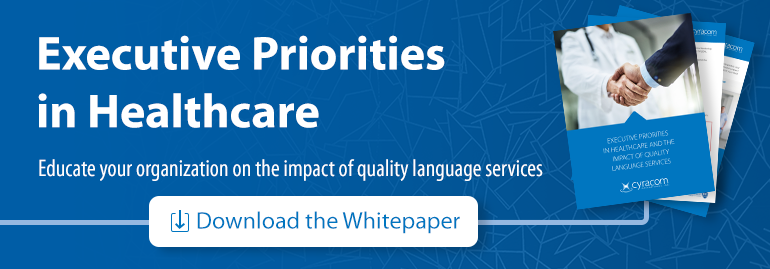
PubMed.gov recently published a review entitled Patient Satisfaction of Telephone or Video Interpreter Services Compared with In-Person Services. The review compiled the results of eight separate studies, each of which sought to compare patient satisfaction when using either phone or video interpretation to that of an on-site interpreter.
Since patient satisfaction and HCAHPS scores often make the shortlist of hospital executive priorities, understanding how language services – and specifically the choice of interpreter modality – impact these metrics is critical for healthcare language services professionals.
Some relevant findings from PubMed’s review:
1. There is evidence of higher satisfaction with hospital-trained interpreters compared with ad hoc (friend or family)
Section 1557 of the Affordable Care Act requires providers to use qualified interpreters for every limited-English proficient (LEP) patient encounter, stating that patient friends and family should not act as interpreters. Providers may worry that refusing to allow patients to use their friends and family as interpreters could upset them; in fact, research revealed that using professional interpreters correlated more highly with patient satisfaction than did utilizing ad hoc individuals.
This particular study looked at on-site interpreters as compared to patient friends and family, but the deciding factor appears to be training; those who had it outperformed their “amateur” counterparts, leaving patients more satisfied.
2. There is no difference in satisfaction between in-person interpreting, telephone interpreting, or interpretation provided by the treating bilingual physician
Providers have long recognized the convenience and cost-effectiveness of supplementing their in-person interpreters with phone interpretation services from partners like CyraCom. These services enable hospitals and healthcare organizations to:
- Access interpreters in seconds
- Care for patients who speak languages too rare to justify a full-time staff interpreter
- Avoid the cost of bringing in on-site interpreters with two-hour billing minimums for a five-minute patient conversation
Now, providers can add the fact that patients appear to be equally satisfied with a phone interpreter to that list of advantages. This information may also prove useful in persuading bilingual physicians who have not met the standards for qualification outlined in Section 1557 to stop acting as interpreters themselves.
3. Video interpreting has the same satisfaction as in-person interpreting
Like phone interpretation, video interpretation enables providers to connect to a live interpreter in seconds, without waiting for someone to arrive in person from off-site or paying for more interpreter time than the patient actually needs. And video interpretation, with its added visual component, can substitute for on-site interpreters in scenarios where phone interpretation alone wouldn’t suffice. The review confirms that patients are no less satisfied with video interpretation as compared to on-site options.
The PubMed review findings build on what we already know: that access to interpreters improves the patient experience for LEP patients. We can now add the fact that patient end up more satisfied with trained interpreters than they would be using friends and family to communicate, and that interpreter modality – phone vs. video vs. on-site – does not appear to impact patient satisfaction in a measurable way. This leaves language services leaders in a position to advocate for the use of professional interpreters, and to utilize the interpreter modality which best fits each individual situation.
Want to learn more about how quality language access solutions impact the metrics your executive team cares about? Take a look at our whitepaper:




